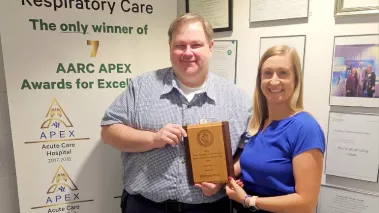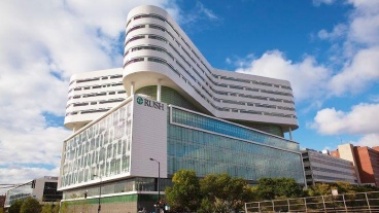Dr. Larry Goodman, CEO of the Rush University System for Health (RUSH) and Rush University Medical Center will retire in the next several months, the RUSH Board announced today.
Given the magnitude of his current responsibilities and aligned with the organization’s strategic vision, Goodman’s roles will be assumed by two accomplished leaders. Dr. Ranga Krishnan, currently dean of Rush Medical College and senior vice president of the Medical Center, will become CEO of the Rush University System for Health. Dr. Omar Lateef, currently chief medical officer for the System and the Medical Center, and senior vice president of medical affairs for the Medical Center, will become CEO of Rush University Medical Center.
These changes are the culmination of an extensive Board-led succession planning and evaluation process over the past 14 months. The CEO Succession Planning Committee of the Board evaluated a diverse pool of highly talented internal and external candidates that could lead RUSH and the Medical Center successfully during a time of dramatic change in health care in the United States.
This thoughtfully planned leadership transition follows the appointment of Rush University’s new president, Dr. Sherine Gabriel, in October. Over time, the committee concluded that the potential for growth of both the System and the Medical Center has been and will continue to be significant and that each needs its own leader.
“Dr. Goodman has been a truly transformational leader during his 17-year tenure,” said Susan Crown, chairman of the RUSH and Medical Center boards. “He has strengthened our financial footing, elevated clinical excellence, built a renowned health science education program and significantly expanded our reach to patients throughout the Chicago area. His efforts have left an extraordinary mark for which we will be forever grateful.”
“It is a testament to Larry’s extraordinary leadership that we are now dividing his role among two highly accomplished leaders in their own right,” Crown continued. “It is unusual, and runs contrary to common practice, for a single leader to run a university, a flagship hospital, and a health care system with the exceptional skill and vision Dr. Goodman has demonstrated. As we continue to pursue our long-term vision of being nationally recognized for transforming health care, it is clear that Dr. Krishnan and Dr. Lateef are the leaders we need to continue the System and Medical Center transformation.
“We are very fortunate to have this high level of diverse talent within the Rush system, and we are confident that Dr. Krishnan, Dr. Lateef and Dr. Gabriel will continue our visionary leadership and successfully build on our efforts to be a leading and transformative health care institution.”
Goodman transformed Rush during 17 years as CEO
Goodman has been CEO of the Medical Center since February 2002 and also served as president of Rush University until Gabriel assumed the role this February. He additionally assumed the role of CEO of RUSH when the System was formed in March of 2017. He also holds the academic rank of professor of internal medicine and is the James A. Campbell, MD, Distinguished Service Professor of Rush University.
Under Dr. Goodman’s leadership, Rush University Medical Center has been nationally recognized for excellence in patient care, breakthrough research, community engagement and technological innovation, while also increasing financial stability and strength.
Goodman’s tenure as CEO has included the $1 billion transformation of the Medical Center’s campus on Chicago’s West Side; recognition that includes a steady stream of honors for excellence in care from Vizient, U.S. News & World Report and the Leapfrog Group; student enrollment in Rush University more than doubling; a thriving research enterprise that received the highest level of NIH funding in Rush’s history last year; and the formation and rapid expansion of the Rush University System for Health.
RUSH includes Rush University Medical Center; Rush University; Rush Oak Park Hospital in Oak Park, Illinois; Rush Copley Medical Center in Aurora, Illinois; their respective subsidiaries and affiliates; and numerous outpatient facilities in the Chicago area.
In just the past three years, the System has added outpatient centers in Chicago’s River North and South Loop neighborhoods, and Oak Brook, Illinois. More are planned. The System shares a best in class electronic medical record system, and all have a common commitment to the highest quality and best patient experience.
Read more about these achievements and Goodman’s major accomplishments at Rush.
“It has truly been a special honor and a privilege to be a part of the extraordinary transformation at Rush and to serve alongside the Rush community, with a singular focus on improving health,” Goodman said. “I came here as a resident in internal medicine in 1976 and met my wife here, so Rush has always been like a family and like home to me.
“I am proud of our many successes together, which is unquestionably due to the great work of so many others, including our wonderful Board. I am grateful to have served in this role. I also always have known that there would come a time for me to step down.
“I approached the Board well over a year ago so they could begin the succession planning process. It has been deliberate and thoughtful, and I’m thrilled for Dr. Krishnan and Dr. Lateef. They will provide the leadership necessary to take the Rush system and Rush University Medical Center to the next level and further ensure the System is positioned to be the model of the future of health care in this country.”
Krishnan has pioneered new teaching methods
Dr. Ranga Krishnan joined Rush in October 2015 after 34 years in clinical and leadership roles at Duke University in Durham, North Carolina. As the Henry P. Russe, MD, Dean, he transformed Rush Medical College’s curriculum to be in the vanguard of medical education, engaging medical students in active, team-based learning. He has redesigned numerous clinical departments to improve efficiency and patient outcomes, and he has led the ongoing development and growth of the Rush University Cancer Center.
Previously, Krishnan helped establish and led Duke-NUS Graduate Medical School Singapore, a joint venture between Duke and the National University of Singapore. During Krishnan’s eight-year tenure as the school’s dean, Duke-NUS developed a new teaching method called Team LEAD (for Learn, Engage, Apply, Develop) that since has been adopted by other universities around the world.
Krishnan is a renowned practitioner and researcher of psychiatry and behavioral sciences. He is an elected member of the National Academy of Medicine, one of three academies that make up the National Academies of Sciences, Engineering, and Medicine.
“I’m humbled at the opportunity to lead the Rush system at a time of fundamental change in health care and health science education,” Krishnan said. “We have incredible opportunities to make a profound impact on the lives of our patients, our students, our employees and our care model while we continue to make Rush a destination for the best medical care in the world and the home of the country’s leading health sciences university.
“Drs. Lateef and Gabriel are terrific partners,” Krishnan continued. “Together we will work to find solutions that address some of the greatest challenges in U.S. health care today, including the ability to deliver exceptional quality more efficiently and at lower costs within our communities.
“I am also looking forward to partnering with Rush system president Mike Dandorph, who will continue his important System role, to further develop our growth plans and strategy, including partnerships with industry leaders, further defining the System’s structure and how we function collaboratively as a System.”
“This will be a multi-pronged effort that must involve our medical system, Rush University, businesses and our communities to create a path toward better health equity. With the system we have built together — combining education, research and clinical delivery — the Rush system is in a unique position to innovate patient care and educate and nurture the health care leaders of the future.”
Lateef has led clinical excellence to new levels
Dr. Omar Lateef has been Rush University Medical Center’s chief medical officer since January 2015 and the Rush system’s CMO since June 2018. In these roles, he has helped design, implement, and oversee Rush initiatives related to clinical quality, patient safety and performance improvement.
Reflecting these efforts, in October, Rush University Medical Center was ranked second in the nation among 99 leading academic medical centers in the latest annual quality and accountability study conducted by Vizient Inc. Lateef has conducted groundbreaking work in data analytics, including recent analyses of external quality rankings that have led to changes in ratings methods that have benefited patient care.
Lateef, who joined Rush in 2002, was appointed associate chief medical officer in 2009 and vice chairperson of the Department of Internal Medicine in 2012. He also served as program director for the Pulmonary and Critical Care Fellowship Program and as director of the medical intensive care unit. A former associate dean of medical sciences at Rush University, Lateef is a professor of medicine and holds the Stuart Levin, MD, Presidential Chair.
“I am excited and honored to lead this incredible institution and the great people who work at Rush University Medical Center,” Lateef said. “I first came to the Medical Center for a fellowship in pulmonary and critical care, and I am so grateful for the tremendous opportunities I have been provided to learn and grow as a physician and leader. I look forward to working with an incredible leadership team and continuing to build upon Dr. Goodman’s great accomplishments.”
“Dr. Krishnan, Dr. Gabriel, Mike Dandorph and I all believe we have tremendous opportunities to advance the quality, safety and cost savings of medical care in this country, and to do so in a way that is both patient and physician-centered and easy for people to navigate. This goal will require both clinical innovation and the transformative health education and research that Rush University provides. I look forward to working closely with our exceptional leadership team to achieve our vision of the future of health care.”
Gabriel is first Rush University president focused solely on the University
The appointments of Drs. Krishnan and Lateef follow the appointment last October of Dr. Sherine Gabriel as the first president of Rush University focused solely on the University. (Previously the Medical Center’s CEO also served as the University’s president.) Given the University’s growth under Goodman’s leadership and great potential for further growth in a time of anticipated health care worker shortages, it became apparent that the University president was a full-time position.
Dr. Gabriel spent most of her academic career at the Mayo Clinic, which like Rush tightly integrates health science education within an academic health system. She has had a distinguished career as a researcher in rheumatology, a clinical leader and an education specialist, previously serving as the dean of the Mayo Medical School. She assumed her duties as Rush University’s president Feb. 1, 2019.
About the Rush University System for Health
Rush is an academic health system whose mission is to improve the health of the people and the diverse communities it serves through the integration of outstanding patient care, education, and research and community partnerships. The Rush system comprises Rush University Medical Center, Rush University, Rush Copley Medical Center and Rush Oak Park Hospital, as well as numerous outpatient care facilities. Rush University, with more than 2,500 students, is a health sciences university that comprises Rush Medical College, the College of Nursing, the College of Health Sciences and the Graduate College.
Formerly known as the Rush system for Health, the Rush University System for Health (RUSH) officially added University to its name this month to properly reflect its identity as an academic health system.







